A practical sandwich pipe chimney has many advantages. It is a lightweight, reliable, safe and aesthetic option that is ideal for private buildings. It consists of separate elements, so it does not cause any problems during the assembly stages. Before installation, it will be useful to study its structure from the inside and from the outside, evaluate the pros and cons, get acquainted with the permissible standards and dimensions, and also learn about the available installation methods.
Chimney device made of sandwich pipes
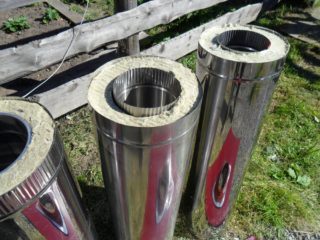
Outwardly, a sandwich chimney looks like a double-circuit element in the form of a cylinder, which consists of two or three sections of pipes with a length of no more than 1 meter. During installation, these pipes are tucked into one another, following the example of the designer. The contours of such chimneys are made of rolled pipes on the outside, and a material for thermal insulation is laid between them. Most often it is mineral wool, basalt fiber or vermiculite, these components do not allow the air outlet to cool down and prevent the accumulation of condensate from the inside. Internal circuits are most often made of heat-resistant steel, which is resistant to corrosion.
A chimney made of sandwich pipes can be internal or external, taking into account the placement of the boiler or furnace, the amount of free space and the structural details of the element itself. The outdoor version is a smoke evacuation system that connects the outlet to a pipe that goes through the wall to the outside. To ensure optimal draft, the height of the chimney pipe must be made no lower than or higher than the minimum level of the ridge. The length of the section horizontally cannot be more than 1 meter, the distance from the extreme corner of the roof must be at least 0.5 meters. Installation of a chimney from a sandwich pipe from the outside requires the installation of a separate device for insulation.
The internal chimney system has a vertical structure, it is located inside the house and taken out into the street through the roof. The connection of the elements is carried out outside the attic floors and between floors in order to avoid the formation of obstacles when it is necessary to check the tightness. In the sections of the passage, the structure must be additionally protected from the influence of high temperatures by means of bushing elements and a passage for the roof. Roof-coated joints can be sealed using a special cut.
Installation of the pipe inside vertically increases the stability of the draft; such chimneys are simpler and do not cause difficulties during the installation process.
Advantages and disadvantages
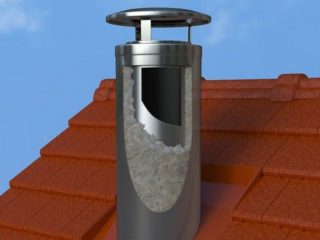
Before starting the installation of a sandwich pipe chimney through the roof, you need to familiarize yourself with all the advantages and disadvantages of this design. The list of the main advantages includes:
- no problems with internal or external installation;
- good sound insulation properties due to the three-layer structure of the pipe walls;
- compatibility with heating appliances of all types;
- aesthetic appearance, versatility and low weight of the structure;
- optimal heat-shielding properties;
- increased level of fire safety;
- the smoothness of the inner surface of the pipes, almost not subject to the accumulation of soot;
- long service life.
The device of air ducts from sandwich elements has its drawbacks. The loss of tightness is provoked by the reaction of the material of the constituent elements to temperature extremes. Consumers also note the high price of this type of system.
The thickness of the heat insulator must be selected taking into account the temperature of the exhaust gases. If boilers of low or medium power are installed in the room, which can heat up to 250 degrees, an insulating layer with a density of up to 30 mm is suitable for them. In more powerful gas and oil installations, this value should not exceed 50 mm. Solid fuel coal units, in which smoke can heat up to 1000 degrees, must be equipped with a heat insulator no more than 100 mm thick.
Choosing a sandwich chimney
To carry out the installation of a chimney from any sandwich pipes according to the rules, you first need to decide on the choice of the main material, as well as auxiliary elements and components.
Materials used
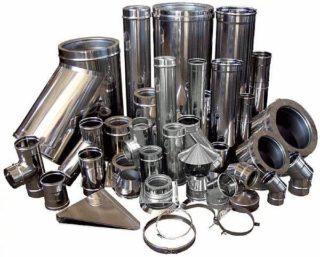
The type of material is selected taking into account the specific heating device and the type of fuel. For modern chimneys, high-strength steel or ferrous metal is most often chosen. The list of the most reliable steel alloys includes stainless material stabilized with titanium or molybdenum of AISI 321 and 316 categories, as well as heat-resistant steel of AISI 304 type. installations on gas or diesel fuel.
Heat-resistant steel contains chromium in combination with nickel, which are insensitive to high temperatures and oxidized environments. Ferrous metal is also suitable for chimney pipes. Since it is capable of burning and oxidizing, it is additionally covered with a layer of special enamel. Tubes with enamel can be used for a long time when heated up to 400 degrees and with a rapid rise to 750 degrees. Combined sandwich chimneys are also in demand, they are more economical counterparts, consisting of double pipes made of different materials.
When choosing combined parts, you need to look at the materials from which they are made. Internal pipes must be made of durable stainless steel, only in this case they will last as long as possible.
Required details
In addition to the chimney, for its installation, it is necessary to purchase additional parts that will become elements of the entire system. This includes straight tube elements up to one meter in length and with a diameter of up to 80-600 mm, as well as elbows and tees designed to lead through a wall to the street or to bypass beams or rafters. In addition to these parts, they buy passages for insulating pipes from interfloor partitions and a metal cone for cutting the roof.
Prices
The chimney assembly can be carried out independently or by specialists. Although the installation of the structure is not difficult, at some stages of the assembly problems may appear that only professionals can fix. The cost of installation and assembly work will depend on the length of the canal, the type of its placement, as well as the number of overlaps. Usually it varies between 1,700-2,000 rubles per meter.
Installation of a chimney from sandwich pipes
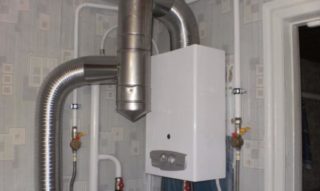
Before installing the chimney, you need to select the main part and additional materials, depending on the type of heating device. For units that run on gas fuel, the most budget models are suitable, if we are talking about a traditional or bath-type stove, it is worth giving preference to a high-quality and more expensive system. First, the air duct is connected to the boiler, then it is brought out through the ceiling to the roof.
To the boiler
A boiler with a horizontal outlet on the monotube side can be fixed using a mono-tee, supplemented with a plug with a condensate collector. The surface of the exit to the center from the inside is covered with a sealed layer with a heat-resistant effect. After that, the tee is tightly put on the stove pipe, pushed to the end and fixed in the connecting part with the bracket with a clamp according to the rules. It is important to check the verticality of any axis of the tee in advance, only after that it is allowed to attach it to the wall surface with anchors or dowels.
Through the ceiling and roof
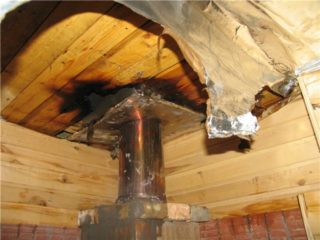
With a phased installation of the air duct, the section for removing the tube will need to be shifted to one of the sides in the direction from the ridge. If it passes through it, the structure of the ridge beam and rafters will be disrupted during the installation of the pass-through assembly. The sandwich pipe is installed through the ceiling in accordance with all building codes and fire safety regulations.
After choosing a suitable place, you need to make a hole according to the preliminary marking. Then it is attached to the ends with nails or self-tapping screws and the edges are punched with a heat-resistant insulator. It is necessary to assemble the ceiling pass-through assembly according to the scheme, the box itself is attached to the ceiling using self-tapping screws. Further, the sandwich structure is pulled through the knot and is fixed mainly vertically.
The free space inside the box must be filled with expanded clay or mineral wool for thermal insulation. At the final stage, the hole is closed with a sheet of stainless steel.
Correct design of the roof outlet
The installation of a chimney from sandwich pipes through any roof must be carried out according to the rules so that the part is installed at an acceptable height and provides good traction performance. In this case, the removal of combustion products will be as efficient as possible regardless of the weather. The total length of the entire system should not exceed 5 meters; you can only deviate from this value downward. In the presence of a flat roof, the height of the tube in the standard version cannot be more than 0.5 meters. During the installation of the chimney communication, the placement of the floor beams and the roof truss system is taken into account.
DIY step-by-step assembly instructions
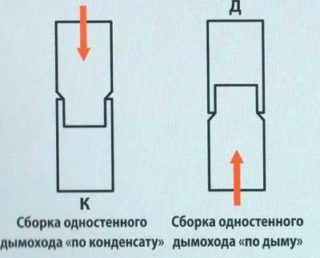
The system begins to be mounted from the bottom up by mounting an adapter or a single-walled steel tube at least half a meter long. It must be installed in smoke, that is, put on the heating pipe from above and close the joints with a heat-resistant sealant. The rest of the elements will be installed over the condensate in order to prevent its leakage and damage to the heat-insulating layer. All fasteners are supplemented with couplings, a clamp is placed near all joints, which helps to attach the system to the wall surface. The surfaces of the chimney can become very hot despite the insulating layer, therefore they should not be placed near materials that are liable to fire.
When the tube exits through the passage, its tightness may be broken. To strengthen, protect from parts that can catch fire, and eliminate possible leaks, special roofs in the form of cones and silicone seals are used. When placing the tube, a distance is allocated to materials prone to fire, which should be at least 37 cm. To protect the roof from water ingress, an apron is mounted in the upper part of the roof and its edges are brought under the roof covering. The height of the chimney pipe will depend on the distance between its beginning and the ridge. The upper part of the element should rise above the roof surface by 1.5 meters in the presence of buildings nearby.
When using flammable materials for the roof, a spark arrester is placed inside the duct. The chimney system must be supplemented with a cone-shaped head part, which can be additionally protected with a deflector or other device.








